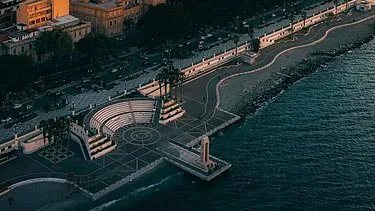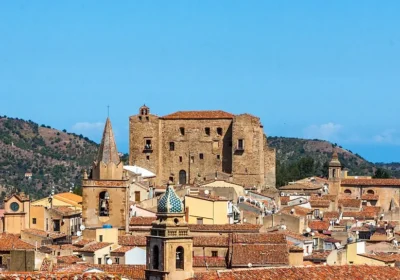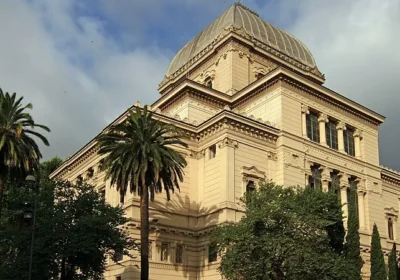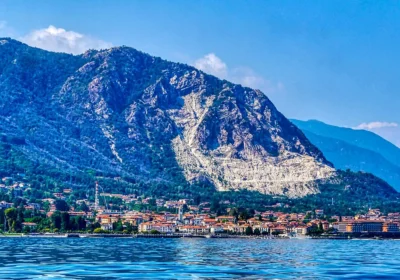Tour 1 “Sea and Mountains” Scylla and Aspromonte – Duration of the tour is 4-5 hours.
In the morning visit to Aspromonte National Park, its name means “harsh-unapproachable mountains”. But these mountains welcome the traveller with their pristine nature, mountain rivers, waterfalls, panoramic balconies. Here you can pick mushrooms in autumn, and in winter you can go skiing in the high mountain town of Gambarie. A cable car takes you up to 1700 metres above sea level and from there you can admire the breathtaking view of the Strait of Messina and Sicily with its Etna, and in clear weather you can distinguish the Aeolian Islands to the right of Sicily. 30-40 min by car downhill and you are already on the sea, in the resort town of Schilla (Scylla). It was sung by Homer in the legends of Odysseus and Argonauts’ voyages. Scylla, a terrible monster, dwelt opposite to another monster – Charybdis, which was waiting for seafarers from the opposite Sicilian coast. The legendary Spartacus also visited here, camping in Scylla in the hope of crossing to Sicily. Today it is a marvellous resort town in the most picturesque location on a promontory at the entrance to the Strait of Messina, the shortest distance between Calabria and Sicily. From here, the Sicilian coast is in plain sight, with a good view of Lake Gancirri, where mussels are farmed, and some of the Aeolian Islands. Here you can visit the Castle of Ruffo from the 5th century BC, The Church of the Holy Spirit, the fishing village of Chianalea, called the “Venice of the South”, Marina Grande, where you can stroll along the sea, sit in one of the many restaurants or cafes, as well as and taste the local ice cream.
TOUR 2 “Pearls of the Coast of the Gods” Tropea and Pizzo – Tour Duration 4 – 5 hours.
Tropea is called the pearl of the Tyrrhenian coast. In the narrow streets of the historic centre of this spa town you can admire the ancient palaces of the nobility, the churches, the Romano-Norman cathedral and suddenly find yourself on panoramic platforms overlooking the emerald sea and the island of St. Mary with its characteristic sanctuary.
The medieval town of Pizzo is characterised by its special architecture and panoramic terraces. One and a half kilometres from the town is the unique church of Piedigrotta, dug in tuff three hundred years ago by Neapolitan sailors who escaped a shipwreck. It was later enlarged and beautified by local craftsmen. In Pizzo there is a castle built in 1492 by Ferdinand D’Aragon, where King Gioachino Murat (Napoleon’s brother-in-law) was imprisoned and where he was shot on 13 October 1815. The castle halls still contain documents and paintings from that era. Nearby is the Baroque church of San Giorgio with sculptures dating back to the 500s AD. It would be unforgivable to visit Pizzo and not sit in one of the cosy cafes on the square and taste the famous ice cream, the most famous brand of which is tartufo.
Tour 3 “Immersion in the Middle Ages” Stilo and Serra San Bruno – Duration of the tour 5-6 hours.
In the middle reaches of the Stilaro River at the foot of Mount Consolino, the mountainous medieval town of Stilo is conveniently located. Its observation deck offers dizzying views of the Calabrian hills and the Ionian Sea. The Byzantine church of Cattolica is world famous, as well as the Norman Castle. In the city centre, the Abbey of San Giovanni Teristis is well preserved, while in the main square Carnovale, the Chiesa di San Francesco dei Minori and the Dolphin Fountain are worth seeing.
From Stilo you will move to the mountains (40 min.), in the heart of the Sila National Park, where you will encounter the marvellous forest town of Serra San Bruno with its Baroque churches and the Certosa Museum (Men’s Monastery). The local churches are characterised by stone portals and wooden furnishings. The Men’s Monastery – Certosa was built by St Brunone in the 12th century. If you wish, you can visit the museum, which has about 20 rooms. Only a few hundred metres separate the Certosa from Lake San Bruno and from the Church of Santa Maria del Bosco, built by Ruggero Norman. Upon prior agreement, lunch can be spent in the woods of St. Maria, where you can also discover the National Park of Force with its chamois and fallow deer.
Tour 4 “From Ancient Greeks to Byzantines and Normans” Locri and Gerace Duration of the tour 5-6 hours.
The archaeological area of Locri Epicefiri is an open-air museum. The ancient Lokri Epizephiri was founded by Greek colonists from Lokrida in 623 B.C. To this day the area of the Ionian coast for several kilometres around Lokri is called Lokrida. Its heart, the town of Locri, is the most historically interesting of all the towns in the south of Calabria. Of great interest are the excavations, especially the archaeological area of a hundred rooms – an ancient commercial area dating back to 600 BC!You can visit the “Antiquarium”, a local museum, where all the objects found during the excavations in this area are exhibited.
Further on, you can go to Gerace (15 min.) a medieval town located a few kilometres from Locri, on top of a 500-metre cliff. The name of the town is of Greek origin and translates as “hawk-quail”. According to legend, the first inhabitants of this place, fleeing from a Saracen attack in 915, followed a hawk that led them to the mountains…
This is a special “timeless” atmosphere, civilisation has hardly touched this settlement and has not disturbed its medieval tranquillity. A special attraction of Gerace is the Norman Cathedral (XII century), whose central entrance is decorated with Roman columns and capitals. It’s worth a peek into the chapel to see the riches of ancient Greece.
Tour 5 “Pentidattilo – Ghost Town and Italy’s most beautiful kilometre in Reggio” – Pentidattilo e Reggio di Calabria – Duration of the tour 5-6 hours.
The ghost town of Pentidattilo, shrouded in legend, is picturesquely embedded in the rocky terrain of Mount Calvary, which is shaped like a giant five fingers, which is where the name comes from: daktylosPenta – five fingers. Imagine a small mountain settlement, with preserved houses, streets and a church, but without people. People left it many years ago. It is rumoured that ghosts can be seen in Pentidattilo. In the Middle Ages a terrible tragedy, akin to Shakespeare’s Romeo and Juliet, took place here, and since then the unsettled souls of the murdered have been wandering these streets. But all fears are dispelled by an annual international short documentary film festival held in late August.
The belvedere offers mesmerising views of the Ionian Sea, Sicily’s towering Etna volcano and neighbouring hills and valleys. After exploring Pentidattilo, tourists can go down to the sea to the wide beach of Anna and swim in the Ionian Sea.
Reggio Calabria is the regional centre and the largest city in the region. The poet Gabriele D’Annunzio, after seeing the exotic planted promenade of Reggio Calabria, with the Strait of Messina as a backdrop, praised it as “the most beautiful kilometre in Italy!”. It is no exaggeration to say that this “kilometre” stretches further along the whole of Calabria, impressing with the diversity and pristine beauty of its landscapes. The land is literally imbued with beauty and harmony. It is this region that gave mankind two great knights of beauty – Tommaso Campanella, who created the utopia of ideal life “City of the Sun”, and the unrivalled fashion artist Gianni Versace. In the National Museum of Greater Greece, at the beginning of the promenade, in the archaeology department, the famous bronze figures of warriors from Riace (5th century BC) are on display, they are truly unique. In addition to the bronze figures, the museum has a rich collection of the historical heritage of the peoples who inhabited this land. The Ancient Greeks left the deepest trace in the history and culture of the region. At that time Reggio was a very important Greek city, where one of the most famous philosophical schools, the Pythagorean School, was founded in the 6th and 5th centuries BC.
Reggio Calabria is characterised by two unique features: fata morgana and bergamot. The fata morgana is an unusual mirage that appears under certain conditions over the Strait of Messina, and can only be seen from the Calabrian side.
Bergamot, the “green gold of Calabria”, grows only in the neighbourhood of Reggio Calabria. Its rind is used to extract essential oils that are widely used in the perfume industry worldwide, an essential ingredient in the production of the finest and most expensive perfumes. Bergamot oils are also used in aromatherapy and medicine.
An optional visit and lunch at the Bergamot Museum based on local products and bergamot.
Tour 6 Statti Farm with tasting and relaxation in nature, shopping in the Shopping Centre “Two Seas” – Duration of the tour 6-7 hours.
The Statti Farm is considered one of the best and oldest (it is more than 200 years old) in Lamezia Terme. Tourists will have the opportunity to experience a modern Italian farm. Here 500 hectares of land with olive groves, citrus orchards and vineyards are cultivated, as well as growing fodder for six hundred cattle; producing 6600 litres of milk per day. A walk through the olive grove with a visit to the farm and the winery with wine and olive oil tasting.
Further shopping in the shopping centre “Two Seas”
Tour 7 Brosio Farm in San Calogero (near Tropea) – Duration 6-7 hours.
Visit a typical Calabrian farm, commune with nature under the shade of olive groves.
Three routes of varying difficulty for trekking in the countryside, taking into account the composition of the group and the wishes of the participants. After the walk you will have the opportunity to bake rustic bread with your own hands, and after the hard work have lunch in the open air on the basis of biologically pure local products and natural cuisine. Here you can also ride horses and socialise with the four-legged and feathered inhabitants of the farm.

















